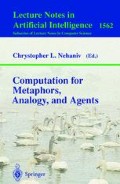Abstract
This paper discusses GAIA (Graphic-Audio Interface Agent), an experimental interface agent used in a pedagogical simulation program, REM(the Re-mapping Europa Mission), where the learning task is the discrimination of specific locations on a series of unlabelled maps. The agent’s task is to enhance the learning experience by providing timely, contextual clues mediated through a graphic/audio interface. Factors that influence such an agent’s ability to provide effective help, such as modes of agent representation, are discussed in the context of differing uses requiring alternative mode choices. The experimental context is explored with an in-depth look at the REM program. The paper concludes with comments on audio interfaces, suggestions for multimodal agent design and likely future directions for multimodal agent interfaces.
Access this chapter
Tax calculation will be finalised at checkout
Purchases are for personal use only
Preview
Unable to display preview. Download preview PDF.
References
Bates, J., The Role of Emotion in Believable Agents. Communications of the ACM, Special Issue on Agents (1994).
Campbell, N., CHATR: A High-Definition Speech Re-Sequencing System. Proceedings of the 3rd ASA/ASJ Joint Meeting, Hawaii, Dec. 23–28 (1996).
Conati, C., Gertner, A., VanLehn, K and Druzdzel, M. J., On-Line Student Modeling for Coached Problem Solving Using Bayesian Networks. Proceedings of the Sixth International Conference on User Modeling (UM-97), Sardinia, Italy (1997).
Creager, W., Simulated Conversations: Speech as an Educational Tool. In The Future of Speech and Audio in the Interface: A CHI’94 Workshop, Arons, B. and Mynatt, E., co-convenors. SIGCHI Bulletin, Vol. 26, No. 4, October (1994) 44–48.
Frasson, C., Mengelle, T. and Aimeur, E., Using Pedagogical Agents in a Multistrategic Intelligent Tutoring System, Proceedings of the Workshop on Pedagogical Agents, World Conference on Artificial Intelligence in Education (AI-ED’97), Kobe, Japan (1997).
Gerber, R., Lidstone, J. and Nason, R., Modelling Expertise in Map Reading: Beginnings. International Research in Geographical and Environmental Education, Volume 1, No. 1 (1992) 31–43.
Grosz, B. and Sidner, C., Attention, Intentions and the Structure of Discourse. Computational Linguistics, Vol. 12, No. 3 (1986).
Hendrix, C., Exploratory Studies on the Sense of Presence in Virtual Enironments as a Function of Visual and Auditory Display Paramenters. M.S.E. Thesis submitted to the University of Washington (1994).
Hofstadter, D., Fluid Concepts and Creative Analogies. The Penguin Press, London (1992) 157.
Isbister, K., Perceived Intelligence and the Design of Computer Characters. M.A Thesis, Lifelike Computer Characters Conference, Snowbird, Utah, Sept. (1995).
Johnson, W. L. and Shaw E., Using Agents to Overcome Deficiencies in Web-Based CourseWare. Proceedings of the Workshop on Intelligent Educational Systems on the World Wide Web, 8th World Conference of the AIED Society, Kobe,Japan, August (1997).
King, W., Anthropomorphic Agents: Friend, Foe, or Folly. Technical Memorandum M-95-1, University of Washington (1995).
Kono, Y., Yano, T., Ikeda, T., Chino, T., Suzuki K. and Kanazawa, H., An Interface Agent System Employing an ATMS-based Multimodal Input Interpretation Method. To appear in the Journal of the Japanese Society for Artificial Intelligence, Vol. 13, No. 2 (in Japanese) (1998).
Nagao, K. and Rekimoto, J., Agent Augmented Reality: A Software Agent Meets the Real World. Proceedings of the Second International Conference of Multiagent Systems (ICMAS-96) (1996).
Oviatt, S., Multimodal Interfaces for Dynamic Interactive Maps. Proceedings of the Conference on Human Factors in Computing Systems (CHI’96), ACM Press, New York. (1996) 95–102.
Picard, R.W., A.ective Computing. MIT Press, Cambridge, Mass. 1997.
Prevost, S., Contextual Aspects of Prosody in Monologue Generation. Workshop Proceedings, Context in Natural Language Processing (IJCAI-95), Montreal (1995).
Rich, C., Window Sharing with Collaborative Interface Agents. SIGCHI Bulletin, Vol. 28, No. 1, January (1996).
Rickel, J. and JohnsonW. L., Intelligent Tutoring in Virtual Reality: A Preliminary Report. Proceedings of the Eighth World Conference on AI in Education, Kobe, Japan, August (1997).
Rudnicky, A.I., Mode Preference in a Simple Data-retrieval Task. Proceedings of the ARPA Workshop on Human Language Technology, San Mateo (1993) 364–369.
Schank, R., and Cleary, C., Engines for Education. Lawrence Erlbaum Associates (1996).
Sloman, A. and Poli, R., SIM-AGENT: A Toolkit for Exploring Agent Designs. In Wooldridge, M., Muller, J., and Tambe, M., editors, Intelligent Agents II: Proceedings of the IJCAI’ 95 Workshop ATAL, August, 1995. Springer-Verlag, Berlin (1996) 392–407.
Author information
Authors and Affiliations
Editor information
Editors and Affiliations
Rights and permissions
Copyright information
© 1999 Springer-Verlag Berlin Heidelberg
About this paper
Cite this paper
Fenton-Kerr, T. (1999). GAIA: An Experimental Pedagogical Agent for Exploring Multimodal Interaction. In: Nehaniv, C.L. (eds) Computation for Metaphors, Analogy, and Agents. CMAA 1998. Lecture Notes in Computer Science(), vol 1562. Springer, Berlin, Heidelberg. https://doi.org/10.1007/3-540-48834-0_9
Download citation
DOI: https://doi.org/10.1007/3-540-48834-0_9
Published:
Publisher Name: Springer, Berlin, Heidelberg
Print ISBN: 978-3-540-65959-4
Online ISBN: 978-3-540-48834-7
eBook Packages: Springer Book Archive

